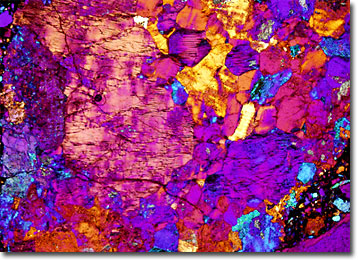Polarized Light Microscopy Digital Image Gallery
Arkose
Sedimentary rocks primarily consisting of grains of sand cemented together, sandstones comprise a significant portion of the Earth's crust. Several different classification systems for the rocks have developed over the years, but the most commonly utilized of these incorporates both textural and mineralogical properties of the material.

Arkose is a coarse sandstone rich in feldspar that typically exhibits a pink, gray, or reddish hue. The substance closely resembles granite, the rock from whose disintegration it is commonly derived, in appearance and is frequently utilized as a building material. Quartz is the principal material in arkose, but feldspar composes at least 25 percent of the material, and calcite, iron oxide, and micas may be present as well. When exposed to dilute hydrochloric acid (a frequent method of quickly indicating rock types), arkose effervesces slightly.
The world's largest monolith, which is located in central Australia, is formed from massive deposits of arkose that were once part of the ocean floor. Known as Uluru to the Aborigines, the natural wonder that rises some 348 meters above the surrounding desert and is approximately 9 kilometers around is sometimes alternatively referred to as Ayers Rock. Breathtakingly beautiful, the colors of the monolith are said to change based on atmospheric conditions and the time of day. Tourists, geologists, and professional photographers alike visit the Kata Tjuta National Park where it is located in large numbers each year. Officially returned to the Aboriginal peoples to who it is religiously and culturally significant by the Australian government in 1985, these indigenous Australians now give regular tours of the site.
